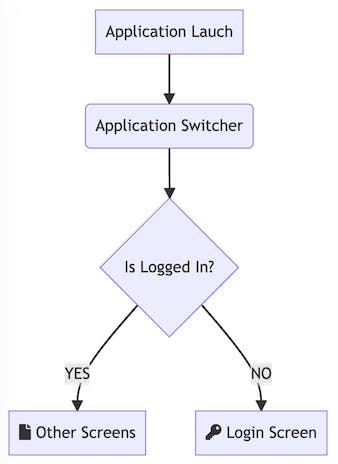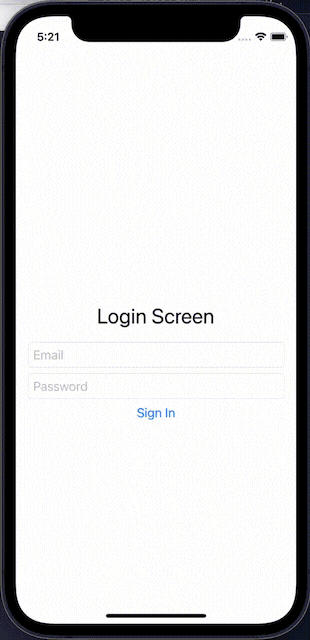EnvironmentObject is useful when you want to create a dependency in a higher component of the layout tree and use it on a lower component without having to pass it down the tree through every child component.
We will now use EnvironmentObject to monitor when a user logs in and out.
- When the user is successfully logged in (isLoggedIn = true), they are directed to the rest of the application views.
- When a user is logged out (isLoggedIn = false) at any point within the app, they are directed to the login page.

We need the following components:
- User State View Model
- Application Switcher
- Login Screen
- Home Screen (Our Application Views)
User State View Model
The user state view model tracks and broadcasts the user status. We store this view model in an EnvironmentObject.
import Foundation
enum UserStateError: Error{
case signInError, signOutError
}
@MainActor
class UserStateViewModel: ObservableObject {
@Published var isLoggedIn = false
@Published var isBusy = false
func signIn(email: String, password: String) async -> Result<Bool, UserStateError> {
isBusy = true
do{
try await Task.sleep(nanoseconds: 1_000_000_000)
isLoggedIn = true
isBusy = false
return .success(true)
}catch{
isBusy = false
return .failure(.signInError)
}
}
func signOut() async -> Result<Bool, UserStateError> {
isBusy = true
do{
try await Task.sleep(nanoseconds: 1_000_000_000)
isLoggedIn = false
isBusy = false
return .success(true)
}catch{
isBusy = false
return .failure(.signOutError)
}
}
}
We make our view model instance available to all child views, starting from the ApplicationSwitcher view
Application Switcher
import SwiftUI
@main
struct LoginFlowApp: App {
@StateObject var userStateViewModel = UserStateViewModel()
var body: some Scene {
WindowGroup {
NavigationView{
ApplicationSwitcher()
}
.navigationViewStyle(.stack)
.environmentObject(userStateViewModel)
}
}
}
struct ApplicationSwitcher: View {
@EnvironmentObject var vm: UserStateViewModel
var body: some View {
if (vm.isLoggedIn) {
HomeScreen()
} else {
LoginScreen()
}
}
}
Login Screen
The Login screen uses the UserStateViewModel to invoke signIn
import SwiftUI
struct LoginScreen: View {
@EnvironmentObject var vm: UserStateViewModel
@State var email = ""
@State var password = ""
fileprivate func EmailInput() -> some View {
TextField("Email", text: $email)
.keyboardType(.emailAddress)
.disableAutocorrection(true)
.autocapitalization(.none)
.textFieldStyle(.roundedBorder)
}
fileprivate func PasswordInput() -> some View {
SecureField("Password", text: $password)
.textFieldStyle(.roundedBorder)
}
fileprivate func LoginButton() -> some View {
Button(action: {
Task {
await vm.signIn(
email: email,
password:password
)
}
}) {
Text("Sign In")
}
}
var body: some View {
VStack{
if(vm.isBusy){
ProgressView()
}else{
Text("Login Screen").font(.title)
EmailInput()
PasswordInput()
LoginButton()
}
}.padding()
}
}
Home Screen with Logout Button
The Home screen uses the UserStateViewModel to invoke signOut
import SwiftUI
struct HomeScreen: View {
@EnvironmentObject var vm: UserStateViewModel
var body: some View {
if(vm.isBusy){
ProgressView()
}else{
Text("Home Screen")
.navigationTitle("Home")
.toolbar {
Button {
Task{
await vm.signOut()
}
} label: {
Image(systemName: "rectangle.portrait.and.arrow.right")
}
}
}
}
}


